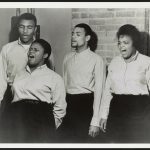HELLO STRANGER: Introducing No Depression’s Spring 2024 Journal + Playlist

Original cover painting by Joan Osborne
EDITOR’S NOTE: Managing Editor Hilary Saunders’ letter, below, opens our Spring 2024 quarterly journal, featuring guest editors The Bacon Brothers and original cover art by singer-songwriter Joan Osborne. Buy the Spring 2024 issue in print or digitally here. Better yet, start a subscription with this issue and help support No Depression’s music journalism all year long.
The sun doesn’t really set in Iceland in the summer. Last July, I had the chance to attend a folk music festival in the tiny northern town of Siglufjörður. Organized by the local Folk Music Center, the five-day annual event highlights Nordic and international folk songs, dances, chants, and more.
Leaving the Herring Era Museum — which hosts many of the festival’s concerts and allows bands to play on its full-sized oak fishing ship from 1946 that’s housed inside — the sky is as blue at 11 p.m. as it was at 11 a.m. As some of the day’s performers join the festival director’s two Gen Z sons in singing a cappella Icelandic choir songs during the most chill afterparty ever, pink clouds streak above the harbor and snowcapped mountains in the distance, signaling that 2 a.m. has come and gone.
Months later, the first snow of the season has finally melted on New York City’s streets. The days are brutally short again, and I’m reminiscing about Icelandic summer with Sigur Rós’ 1999 album Ágætis byrjun on my turntable, a candle from Fischersund (the boutique scent company co-created by Sigur Rós vocalist Jónsi) lit on my coffee table, and a mineral mask from The Blue Lagoon geothermal spa on my face. The papers and booklets and brochures from my summertime travels form a semicircle around me as I cling to these sounds, smells, and memories to try to capture a scene and an experience that are so far from my own daily reality.
One of the weirdest things about being a journalist is being airdropped (in this case, literally) into a different neighborhood, country, culture, or beat and then reporting on it. I’m often torn on how best to achieve this for the sake of the story itself: When I can, I try to empower writers who come from similar backgrounds to report on what’s familiar to them. This often yields more nuanced reporting and can help elevate writers who have been systematically marginalized.
On the flip side, there’s a certain kind of energy to a story when a writer gains entry to a previously unfamiliar environment. Plus, we have to work that much harder to try to understand the community in order to share it as authentically as possible with readers. And personally, any chance I have to travel and report is pretty much the dream.
In Iceland, I was reminded that oftentimes in journalism, the story you think you’re chasing is not always the one that ends up being told. Staying aware, meeting new people, and asking questions are key tenets in this field. But keeping an open mind and infinite curiosity are what keeps the heart in what we do.
I ended up writing about the mostly-Reykjavik-based musicians who are trying to preserve Iceland’s traditional folksongs and build upon such styles for both local and international audiences. There’s no way to summarize the breadth of Icelandic cultural and sociopolitical history in a mere 2,000 words, much less capture the ethos of a scene burgeoning in real time. But after experiencing the remarkable kindness of these musicians, learning about their musical heritage, and sharing maybe a few shots of the country’s infamous caraway-flavored spirit Brennivín, I realized that the story was right there all along: how musical traditions shape our communities and how supporting niche communities can help us build a more diverse and more accepting future.
Listen to our Spring 2024 playlist, featuring songs and artists mentioned in the issue:






